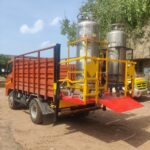Introduction
In industries that rely on gas cylinders for their operations, ensuring safe and efficient handling is a top priority. A Gas Cylinder Tail Lift is a specialized lifting solution designed to make the transportation, loading, and unloading of heavy gas cylinders seamless. These lifts enhance workplace safety, improve efficiency, and reduce manual labor.
This article will explore the benefits, features, and key considerations when choosing a Gas Cylinder Tail Lift for your business.

Why Choose a Gas Cylinder Tail Lift?
Gas cylinders are heavy, awkward to handle, and can pose significant safety risks when manually transported. A Gas Cylinder Tail Lift provides multiple key benefits:
1. Enhanced Safety
Manual handling of gas cylinders increases the risk of accidents and injuries. A tail lift provides a stable lifting mechanism, reducing the chances of mishaps and ensuring compliance with workplace safety regulations.
2. Increased Efficiency
By automating the loading and unloading process, businesses can save time and labor costs. A tail lift ensures a smooth transition from ground level to the vehicle bed, minimizing delays in operations.
3. Versatility Across Industries
From medical and industrial gas suppliers to welding and construction companies, a Gas Cylinder Tail Lift is an essential tool for any business that regularly transports gas cylinders.
Key Features of a Gas Cylinder Tail Lift
Selecting the ideal Gas Cylinder Tail Lift involves a clear understanding of its essential features. Here are the essential factors to consider:
1. Heavy-Duty Load Capacity
A premium Gas Cylinder Tail Lift is engineered to support a wide range of load capacities, typically between 500 kg and 2000 kg. This ensures that even the heaviest gas cylinders can be safely lifted.
2. Secure Holding Mechanism
Gas cylinders must be properly secured during lifting. Many tail lifts come with features such as clamps, safety rails, or strap systems to keep cylinders stable while in transit.
3. Hydraulic or Electric Operation
Contemporary Gas Cylinder Tail Lifts operate using hydraulic or electric systems, ensuring smooth, precise, and controlled lifting performance. Hydraulic lifts offer higher load capacity, while electric models ensure energy efficiency and ease of operation.
4. Space-Saving Design
An efficiently designed Gas Cylinder Tail Lift should be compact and foldable, allowing it to save space on the vehicle when not in operation.
5. Corrosion-Resistant Materials
Since gas cylinders are often exposed to outdoor conditions, the tail lift should be made from galvanized steel or aluminum to resist rust and corrosion.
6. Easy Maintenance & Durability
When investing in a Gas Cylinder Tail Lift, durability is a key factor to consider. Low-maintenance models with sealed hydraulic systems and heavy-duty components ensure long-term efficiency and reliability.
How to Choose the Best Gas Cylinder Tail Lift
When selecting a Gas Cylinder Tail Lift, consider the following factors:
1. Load Capacity Requirements
Assess the maximum weight of the gas cylinders you need to transport. Selecting a lift with the appropriate weight capacity helps prevent overloading and reduces the risk of mechanical failure.
2. Vehicle Compatibility
Ensure the tail lift is compatible with your truck, van, or trailer. Different vehicle types require specific mounting solutions to ensure proper functionality.
3. Safety Features
Look for additional safety elements like anti-slip platforms, emergency stop buttons, and overload protection to enhance operational security.
4. Operational Speed
A quick and efficient tail lift reduces loading time, making it ideal for businesses managing large volumes of gas cylinders.
5. Compliance with Regulations
Make sure the Gas Cylinder Tail Lift complies with industry safety standards and regulations, including ISO certifications and workplace safety guidelines.
Applications of a Gas Cylinder Tail Lift
A Gas Cylinder Tail Lift is extensively used across multiple industries, such as:
Installation & Maintenance Tips
For optimal performance, adhere to these installation and maintenance guidelines:
Installation Guidelines
- Seek professional assistance for installation to ensure proper compatibility with your vehicle.
- Secure all mounting points to avoid movement or detachment during operation.
- Test the lift system before full deployment to confirm proper functionality.
Maintenance Best Practices
- Perform regular inspections of hydraulic and electrical components to check for signs of wear and tear.
- Lubricate moving parts to prevent mechanical failure.
- Check safety mechanisms like clamps and straps to ensure cylinder stability.
- Clean the tail lift regularly to prevent dirt accumulation and corrosion.
Conclusion
A Gas Cylinder Tail Lift is a crucial investment for businesses that regularly transport gas cylinders. It improves safety, efficiency, and reliability by reducing manual labor and minimizing operational risks. By selecting a high-quality tail lift with the appropriate features, companies can streamline workflow and ensure adherence to safety regulations.
If your business relies on safe and efficient gas cylinder handling, investing in a Gas Cylinder Tail Lift is the best way to optimize operations and ensure workplace safety. Select the perfect model today and enjoy the advantages of cutting-edge lifting technology!
